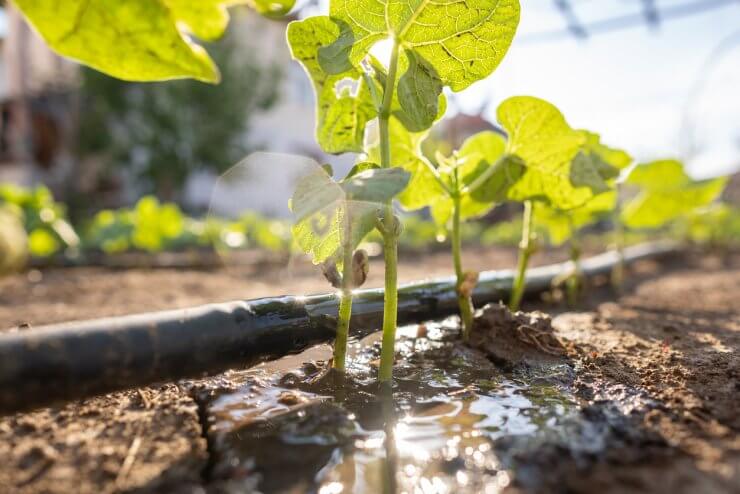
Assess Soil Absorption Capabilities
Overly saturated soils can cause root decay and turn your plant’s leaves yellow or brown. If you spot standing water in your garden after rainstorms, that’s one of the clearest signs that water is stagnating rather than flowing through the dirt.
If you’re unsure of your property’s drainage, you can perform a simple test. Dig a hole about a foot wide and deep, and fill it with water. It should absorb into the soil within eight hours if your garden has adequate water flow.
Similarly, you can check that the water goes down deep enough to reach the roots by digging down about 6 inches around a plant’s base. Soil with a dry and powdery texture at that depth indicates inadequate watering, while soil that’s moist enough will clump together when squeezed.
Consider Using Water and Sediment-Control Basins
Strategically placed basins to catch water and sediment can promote better soil health and water flow. They work particularly well if you garden on sloping lands because the natural incline encourages the liquid to move into the designated locations. Basins can also be a water conservation method because you tap into an often-unnoticed irrigation source.
In one example, property owners who garden and farm on their land installed basins, underground drains and outlets. They noted that the basins prevent gully erosion by affecting drainage areas’ water flow. When the couple bought the land, it was so wet that they could not plant anything earlier than July.
The soil is now so much healthier that some of the produce feeds people in need. The growers nurtured the soil with a Central American technique to grow squash, corn and beans. This approach has increased the dirt’s nutrient and microbial diversity while creating cover crops to protect it through the winter.
The farm’s use of sediment-control basins also supports the landowners’ commitment to reduce the amount of phosphorus entering the nearby Great Lakes Basin. Many commercial water quality improvement efforts involve dredging to remove debris and restore a waterway’s depth. However, this example shows that committed residents living near bodies of water can take individual steps to achieve collective effects.
Analyze Your Soil with Household Items
Although professional soil testing services exist, you can learn a lot by examining it at home. Even better, you don’t need fancy tools and can do this with readily accessible items. The first thing to know is that all soil has varying percentages of sand, clay and silt. The exact makeup determines the texture, which impacts the amount of air and water it holds.
You need:
- A transparent jar.
- A watch or stopwatch.
- A marker.
- A sieve or colander.
- A ruler.
Begin by sifting the soil to remove debris and large organic matter. Then, pour it into the jar until it is one-third full. Fill most of the rest of the container with clean water, leaving a slight amount of space at the top.
Put the cap on your jar and shake it forcefully until the dirt becomes a uniform slurry. Then, set it on a level surface for one minute. Once that time has passed, notice how the sand has settled at the bottom, creating the first layer. Use your marker to indicate how much room that layer takes up in the jar.
After two hours, a silt layer will have formed. Record where it starts and ends with your marker. Finally, leave the jar on its flat surface for two days. The clay layer will have formed by then, and you can mark it on the jar, too.
Now, use your ruler to determine the height of each layer. Then, you can use a soil texture triangle to estimate your garden’s conditions.
Use Additives to Improve Soil Texture Issues
An ideal outcome for the above soil test is that you have approximately equal quantities of clay, sand and silt. However, many people live where the natural soil does not have that desirable balance. If that’s the case for you, there are many simple ways to support better soil health.
For example, if your soil has high clay content, adding organic matter can improve drainage and facilitate proper air and water retention to promote growth. Using mulch or cover crops reduces soil erosion and nutrient runoff. These additions can keep your soil healthy by preventing disruption and letting the food web flourish. Some cover crops — such as clover and buckwheat — can also control pests.
Since working with soil additives can be tricky, consider getting guidance from your local extension office or gardening center. The staff should have specific information about your area’s soil and water flow issues and offer tips to combat problems affecting your property.
Proceed With Patience and Optimism
Whether you have gardened for several decades or are just starting, these tips can help you maximize water flow and soil health to create thriving gardens. As you apply them, maintain a patient, upbeat mood while understanding that learning the best techniques for your area and what you grow can take some trial and error.



